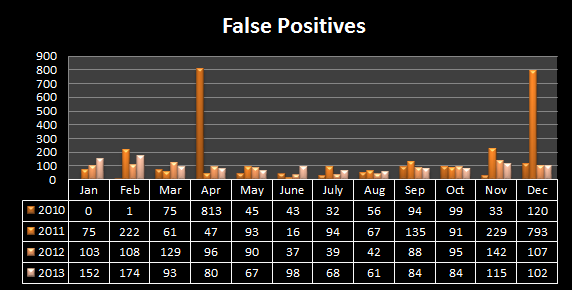Total Meteor Count
Total meteor count includes meteors that:
- Begin outside the FOV and finish inside the FOV
- Begin inside the FOV and finish outside the FOV
- Begin and end outside the FOV
- Have part of their track obscured by clouds
False Positives
False positives occur when the system thinks that it has detected a meteor but in fact has not. The following is a list of false positives detected so far:
1) Lightning
2) Planes
3) Helicopters
4) Electrical Noise
5) Satellites
Every effort is made to tweak the UFO Capture parameters to reduce false positives, whilst not reducing the chance to detect actual meteors.
The following is a breakdown of the false positives. Note that the graph is logarithmic thanks to a huge spike in April caused by a lightning storm.
System Down
Unfortunately, like any complex system, there are times when the system becomes unavailable due to software and/or hardware glitches. Identified problems to date have been:
1) Windows fails to boot
2) System locked up when starting a capture
3) UFO Capture did not start up
4) Human Error (cable accidentally unplugged etc.)
No Meteors Detected
This graph shows how many nights per month there were no meteors detected. The most likely cause is bad seeing conditions, usually caused by cloudy weather (a common occurrence in Melbourne!). The system down count is included to differentiate it as a cause.












